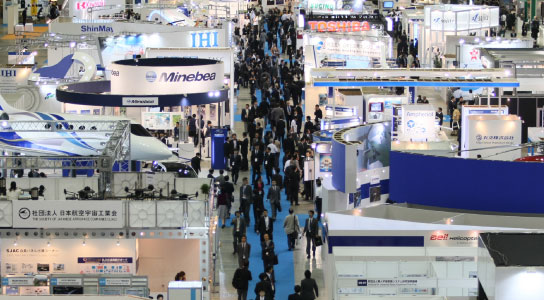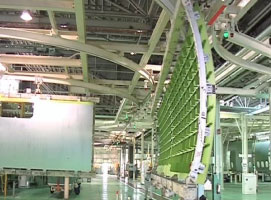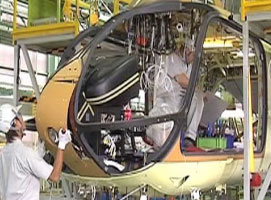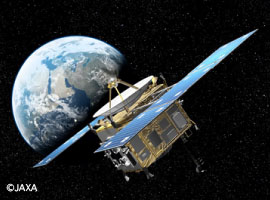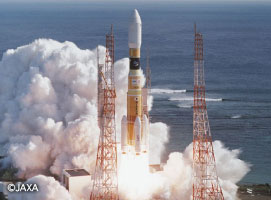
Highlights of JA2012
Public days
The Japan International Aerospace Exhibition 2012 (JA2012) also offers public days, a special opportunity for members of the general public to visit. Details are still pending, and will be announced on the JA2012 website some time during or after January 2012. We appreciate your patience.
What is the Japan International Aerospace Exhibition?
It’s an exhibition of highly specialized technologies held in Japan once every four years, where the world’s major manufactures of aircraft, components, rockets, satellites and other products come together to trade.
Why come to a public day?
Among other things, you’ll be able to see large aircraft up close, and handle various cockpit components. The exhibition area inside Central Japan International Airport - Centrair will host demonstration flights of fixed-wing aircraft, including newly developed models.
There will also be talks by professionals in the aircraft and space development fields, as well as many seminars and symposiums for general visitors. We hope there will be something at the expo for everyone, whether they are university students thinking about careers in aerospace, or people who have never seen these technologies firsthand before.
Exhibition Dates : October 12 (Fri) to 14 (Sun), 2012*
* Port Messe Nagoya, the site for trade-oriented events, will host a students' and recruits' day on Friday, October 12. All university students, job-seeking or not, are welcome to participate, .
Venue
Port Messe Nagoya
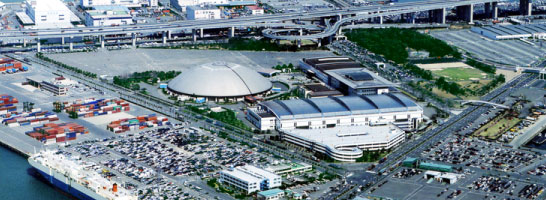
Centrair Airport

Asia's Greatest Trade Show
The Japan International Aerospace Exhibition (JA) was first held in Asia in 1966, and the upcoming event (JA2012) will mark its 13th time here.
The Nagoya region where the exhibition will be held has a large number of plants operated by Japan's major aerospace manufacturers as well as a concentration of several hundred small- to mid-sized companies that support them. It is home to 75% of the Japanese aerospace industry's production, which ranks fifth in the world in sales (approximately 14 billion dollars in fiscal 2008). Therefore, it is anticipated, that JA2012 exhibition will bring together a wide range of people from the Japanese aerospace industry, including engineers, researchers, production managers, representatives of procurement divisions, and managers in charge of planning and strategy.
JA2012 will provide an occasion for exchange of information among aerospace professionals from all over the world. We sincerely hope that JA2012 will also provide significant opportunities for new business expansion.
A Rich History of Space Development
Space projects provide infrastructure that is essential for protecting national security as well as improving our daily lives.
Japan launched its first satellite, "Ohsumi", in 1966, becoming the fourth country in the world to launch a domestically developed satellite with a domestically developed rocket. Later, in 1977, Japan successfully launched a geostationary satellite, which it has since followed with weather satellites, telecommunications and broadcasting satellites, quasi-zenith satellite systems, earth observation satellites, remote sensing satellites, planetary exploration satellites, and so on, all collecting valuable scientific data. In particular, the planetary exploration craft "Hayabusa" achieved success on a global scale when it was launched in July 2003 to land on the asteroid Itokawa in November 2005. It traveled a distance of 6 billion kilometers from Earth and then returned to Japan with samples of asteroid material in June 2010.
Japan also developed and operated various rocket launch systems for space development and use. Its liquid-fuel rockets include the H-II rocket, which has achieved a globally competitive 95% success rate, and its solid-fuel rockets include M-V rockets, among the largest of such launch systems in the world. In September 2009 and January 2011, Japan also successfully launched H-IIB rockets carrying unmanned H-II transfer vehicles (HTV) that fulfilled crucial roles in resupply of the International Space Station.
JA2012 will introduce examples like these of Japan's space technology as well as the history and future prospects of the space industry in Japan.
Expanded Participation
The Japan International Aerospace Exhibition 2008 had exhibits by 529 companies from 22 countries, with as many as 11,000 visitors attending. With this year's event taking place in the Nagoya region, where many of Japan's aerospace manufacturing companies are located, we expect to see an even greater number of exhibitors and visitors alike.
